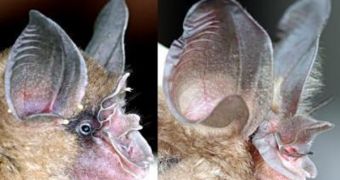For over 60 years, researchers have wondered why the nose of the Bourret's horseshoe bat (Rhinolophus paradoxolophus) is so abnormally large for the animal's size. In a new scientific study that saw the participation of Virginia Tech faculty members, it was proven that the bat actually developed its nose not for frightening the “ladies,” but for generating a highly focused sonar beam, able to give it a better view of its surrounding, and a more complex navigational tool.
The new paper, entitled “Acoustic effects accurately predict an extreme case of biological morphology,” will appear online on July 14th and in print on July 17th, in the upcoming issue of the scientific journal Physical Review Letters, and is authored by Z. Zhang, R. Muller, and S.N. Truong.
Virginia Tech Mechanical Engineering Department Associate Professor Rolf Mueller, who is also the director of the Bio-inspired Technology (BIT) Laboratory, explains that the creature's nine-millimeter-long nose is “so much larger than anything else” in the species, that it captured the interest of science for all these decades. Other horseshoe bats have noses that are proportional to their bodies, and none exhibits the specialization that the Bourret's species does.
“By predicting the width of the ultrasonic beam for each of these nose lengths with a computational method, we found that the natural nose length has a special value: all shortened noses provided less focus of the ultrasonic beam, whereas artificially elongated noses provided only negligible additional benefits. Hence, this unusual case of a biological shape can be predicted accurately from its physical function alone,” Mueller explains, quoted by ScienceDaily.
Bats as a species use their mouths or noses to generate very powerful sonar waves, which they emit in their surroundings. When the sound waves hit an object, their echo reaches the animal and, depending on how diffuse or dampened the sound is, the creatures recognize the objects they are flying towards. The fact that this specific bat came from remote areas in South East Asia may explain why it needs to have a more focused sonar beam, rather than a diffuse one, such as other species with flattened noses do.
This research is part of a larger investigation, conducted on about 120 species of bats, and which is scheduled to be finished sometime in 2010. The goal is for scientists to get a better view of how these creatures managed to guide themselves after sound alone, making little to no use of their sight.

 14 DAY TRIAL //
14 DAY TRIAL //